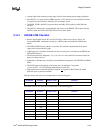
Intel
®
440GX AGPset Design Guide
3-33
Design Checklist
PIIX4E. For ACPI compliance, this signal must be connected to the IOAPIC. There are two
different routing options:
— INTIN9: IRQ9OUT# can be connected to INTIN9 on the IOAPIC. The ACPI BIOS will
report to the OS that the SCI uses IRQ9 for both PIC and APIC enabled platforms.
However, for this solution ISA IRQ9 must be left unconnected. The could create an ISA
legacy incompatibility with ISA cards that must only use IRQ9. Note that this conflict
exists in all PIC enabled systems. The PIIX4E automatically masks ISA IRQ9 when
SCI_EN is set.
— INTIN20 - INTIN22: IRQ9OUT# can be connected to any available IOAPIC interrupt
(e.g. INTIN20-INTIN22 or INTIN13). This solution eliminates the IRQ9 ISA legacy
conflict described in the INTIN9 routing option. However, this routing option creates a
new issue. The ACPI BIOS needs to report to the OS which interrupt is used to generate
an SCI. In a PIC enabled OS (like Windows 98*) the platform would use the PIIX4E
internal IRQ9. In an APIC enabled OS (like NT) the platform would use INTIN20, for
example. The ACPI BIOS has the job of telling the OS which one to use, but the BIOS
does not know which OS will load. If the platform only supports an APIC enabled OS
(Windows NT*-only) there is no issue since the BIOS will just report IRQ20. If the
platform needs to support both PIC and APIC operating systems (NT & Windows 98*),
the BIOS will require a setup screen option that selects between APIC OS (IRQ20) and
PIC OS (IRQ9) so the BIOS can properly report to the OS which interrupt is assigned to
the SCI.
•
The SMI# signal from the PIIX4/PIIX4E should be connected directly to both processors in a
DP system. The option to generate an SMI using the SMIOUT# signal from the IOAPIC is not
recommended because of timing delays through the IOAPIC.
3.18 Manageability Devices
3.18.1 Max1617 Temperature Sensor
•
Sensing temperature on the Slot1 processor is provided by the THRMDP# and THRMDN#
signals. These are connected to a thermal diode on the processor core.
•
Consult the MAX1617 data sheet for the manufacturer’s specifications and layout
recommendations for using this device.
•
D+ and D- are used to connect to the Slot 1 pins B14 and B15 respectively. The MAX1617
measures changes in the voltage drop across the diode and converts the drop into a temperature
reading. An external NPN transistor, connected as a diode may be used on an external cable as
well.
3.18.2 LM79 Microprocessor System Hardware Monitor
•
Consult the LM79 data sheet for the manufacturer’s specifications and recommendations for
using this device.
•
ISA bus interface signals allow access to internal status and control registers such as POST
codes and RAM which stores A/D information. The LM79 internal registers are accessed by
writing a register offset value to IO address 05h followed by a read of IO address 06h.
•
VID[4:0]: These inputs allow storage of the voltage identification pin bits for Intel
®
Pentium
®
II processors to allow the BIOS to record voltage specification variations.
•
Fan inputs can be used with system fans having tachometer outputs.


















